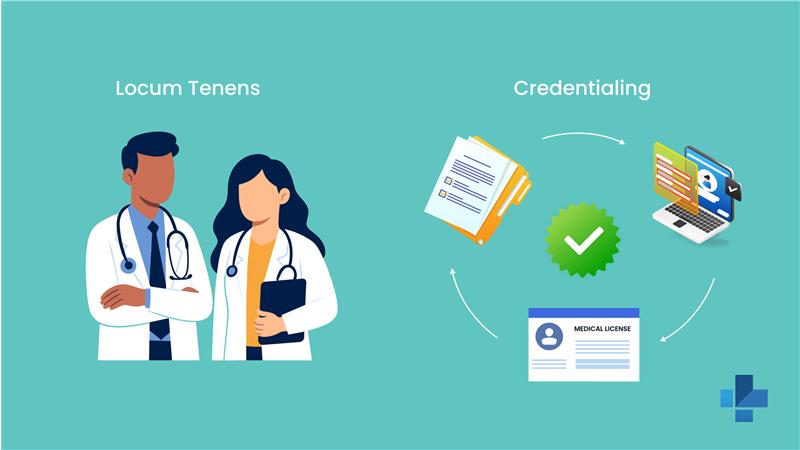
Credentialing is a process where hospitals utilize a systematic process to confirm healthcare providers’ credentials, licenses, and competence. It attests that the temporary employees and locum tenens possess the education, training, and expertise needed to provide safe and efficient care. This is closely related to the privilege that authorizes providers to perform clinical tasks within a facility.
Credentialing locum tenens and temporary healthcare workers is a crucial measure to ensure patients’ safety, that hospitals adhere to the rules, and that employees are transparent. Before providing care, hospitals need to make certain that all of their clinicians, whether their employment is permanent or temporary, have the right training and credentials.
To meet the specific needs of each hospital, locum tenens providers who frequently move between facilities are verified by credentialing.
How to Become a Locum Tenens Physician
The Credentialing Process for Locum Tenens Staff
To guarantee that locum tenens workers are thoroughly screened, hospitals use a systematic and multi-step credentialing procedure.
Step-by-Step Overview:
- A thorough application detailing the provider’s training, education, and work history is submitted.
- Hospitals collect important documents, including board certifications, DEA certificates, medical licenses, vaccination records, and professional references.
- Verification of Primary Sources: The medical staff office obtains credentials directly from original sources, such as training facilities and licensing boards.
- To determine eligibility for privileges, the hospital’s credentialing committee reviews the credentials.
- Final practice privileges are granted by the governing body and the medical executive committee.
Differences Between Locum Tenens and Permanent Staff Credentialing
Both permanent and locum tenens providers go through a strict verification process, but the timelines and scopes of their credentials are different:
- Privilege Duration: Locum tenens privileges are usually granted for shorter periods of time, which frequently correspond to the length of an assignment.
- Accelerated Pathways: Hospitals may use expedited credentialing procedures for temporary employees in order to address urgent staffing needs.
- Regulatory Variations: Hospitals may use streamlined verification for returning patients, but temporary credentials must still adhere to federal and state regulations.
Common Challenges in Locum Tenens Credentialing and How to Overcome Them
Credentialing locum tenens professionals can be difficult because they often move between facilities and states. The challenges include:
- Incomplete Documentation: Approvals may be delayed by missing or out-of-date documentation.
- Multi-State Licensing: Different regulatory requirements are frequently faced by providers operating in multiple states.
- Background and Malpractice Checks: It can take a lot of time to coordinate verifications across several agencies.
Hospitals frequently work with locum tenens organizations and credentialing services to address these issues by streamlining document collection, verification, and compliance management.
Common Challenges in Medical Licensing and How Professional Services Can Help
Compliance and Ongoing Monitoring of Locum Tenens Providers
Credentialing doesn’t end with initial approval; hospitals maintain continuous oversight to ensure ongoing compliance throughout assignments that follow:
- Providers must keep malpractice insurance, DEA registration, and immunization records current.
- Hospitals conduct periodic reviews and audits to confirm continued eligibility.
Hospital Credentialing Committees and Stakeholders
A hospital’s credentialing structure involves multiple departments and decision-makers working collaboratively:
- The medical staff office manages applications, documentation, and verification.
- The credentialing committee reviews and evaluates qualifications.
- The medical executive committee approves privileges and forwards recommendations.
- Administration or governing body provides final authorization.
This organized structure ensures accountability, transparency, and adherence to hospital policies.
Benefits of Partnering with Credentialing Services and Locum Tenens Agencies
Hospitals depend more on locum tenens, organizations, and professional credentialing services to manage the administrative load of compliance and verification.
The main advantages include:
Standardized documentation procedures result in fewer administrative errors.
Quicker onboarding helps hospitals swiftly cover staffing shortages.
Improved adherence to changing state and federal laws.
These collaborations assist hospitals in preserving continuity of care and guarantee the availability of trained professionals when needed.
Why Using a Medical Licensing Service Can Save Time, Money, and Stress
FAQs
- Can locum tenens providers begin working before final credentialing is complete?
In some cases, hospitals may grant provisional or emergency privileges for urgent coverage needs. However, these are temporary and limited until full credentialing is approved.
- How do hospitals handle re-credentialing for repeat locum tenens assignments?
Returning providers typically undergo expedited re-credentialing and verification of only updates since their last assignment.
- How is credentialing managed for locum tenens providers working across multiple states?
Agencies assist in coordinating multi-state licensing and ensure each facility’s compliance with local regulations.
- What are the credentialing considerations for locum tenens involved in telehealth services?
Telehealth providers must be credentialed in the state where the patient is located with proper telemedicine privileges.
- What legal protections do hospitals have regarding locum tenens credentialing errors?
Hospitals maintain protection through credentialing insurance, adherence to policies, and reliance on primary source verification documentation.
Conclusion
Temporary workers and locum tenens must have extensive credentials in order to guarantee patient safety, hospital compliance, and clinical standards are maintained. By using professional credentialing services and maintaining close communication with locum tenens agencies, hospitals can speed up the process, reduce delays, and ensure that only qualified professionals provide care.















